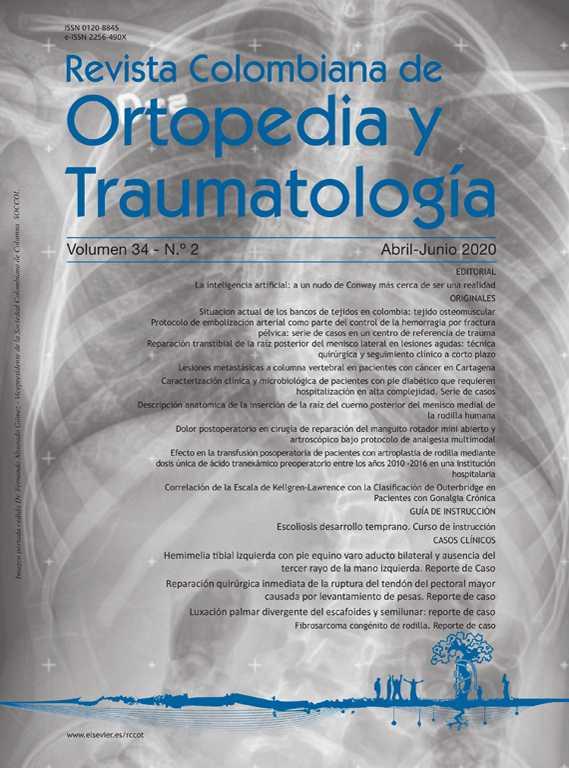Postoperative pain after mini open and arthroscopic rotator cuff repair surgery under multimodal analgesia protocol
DOI:
https://doi.org/10.1016/j.rccot.2020.06.015Keywords:
postoperative pain, rotator cuff, visual analog scale, multimodal analgesiaAbstract
Background: Rotator cuff surgery improve symptoms and function in patients who have not responded to a conservative treatment. However, pain can be severe and uncomfortable after surgery requiring adequate analgesia. We aimed to evaluate pain during the postoperative period after rotator cuff surgery in two different groups: arthroscopic and mini open surgical repair both under a multimodal analgesia protocol.
Methods: Sixty patients were included in the study, 24 patients underwent mini-open surgery and 36 patients underwent arthroscopic surgery between May 2017 and June 2018. Final followup was done on postoperative day 30. The primary outcome is pain according to the visual analog scale (VAS) in the two different groups during different postoperative moments.
Results: Median postoperative pain was lower in patients undergoing mini-open surgery than in patients undergoing arthroscopic surgery on the first postoperative hour (0 vs 4 (p = 0.001)), during the second postoperative hour (0 vs 1 (p = 0.016)) and at final follow up (3 vs 5 (p = 0.043)).
Conclusion: Pain during the postoperative period was lower for patients undergoing mini-open surgery, with a statistically significant difference during the first two postoperative hours and at final follow up. These results can be attributed to the local inflammation of the shoulder caused by the hydration of the tissues with arthroscopy surgery and bigger size tears in the group of arthroscopy surgery.
Evidence Level: I
Downloads
References
Iyengar JJ, Samagh SP, Schairer W, Singh G, Valone FH, Feeley BT. Current trends in rotator cuff repair: Surgical technique, setting, and cost. Arthrosc - J Arthrosc Relat Surg. 2014;30:284-8, https://doi.org/10.1016/j.arthro.2013.11.018
Ensor KL, Kwon YW, DiBeneditto MR, Zuckerman JD, Rokito AS. The rising incidence of rotator cuff repairs. J Shoulder Elb Surg. 2013;22:1628-32, https://doi.org/10.1016/j.jse.2013.01.006
Morse K, Davis AD, Afra R, Kaye EK, Schepsis A, Voloshin I. Arthroscopic Versus Mini-open Rotator Cuff Repair: A Comprehensive Review and Meta-analysis. Am J Sports Med. 2008;36:1824-8, https://doi.org/10.1177/0363546508322903
Huang R, Wang S, Wang Y, Qin X, Sun Y. Systematic Review of All-Arthroscopic Versus Mini-Open Repair of Rotator Cuff Tears: A Meta-Analysis. Sci Rep. 2016, 6(August 2015):22857. Available from: http://www.nature.com/articles/srep22857. https://doi.org/10.1038/srep22857
Williams G, Kraeutler MJ, Zmistowski B, Fenlin JM. No difference in postoperative pain after arthroscopic versus open rotator cuff repair. Clin Orthop Relat Res. 2014;472: 2759-65. https://doi.org/10.1007/s11999-014-3715-6
Pham TT, Bayle Iniguez X, Mansat P, Maubisson L, Bonnevialle N. Postoperative pain after arthroscopic versus open rotator cuff repair. A prospective study. Orthop Traumatol Surg Res. 2016;102:13-7. Available from: http://linkinghub.elsevier.com/retrieve/pii/S1877056815003357. https://doi.org/10.1016/j.otsr.2015.11.005
Pizz LT, Toner R, Foley K, Thomson E, Chow W, Kim M, et al. Relationship between potential opioid-related adverse effects and hospital length of stay in patients receiving opioids after orthopedic surgery. Pharmacotherapy. 2012;32: 502-14. https://doi.org/10.1002/j.1875-9114.2012.01101.x
Uquillas CA, Capogna BM, Rossy WH, Mahure SA, Rokito AS. Postoperative pain control after arthroscopic rotator cuff repair. J Shoulder Elb Surg. 2016;25:1204-13, https://doi.org/10.1016/j.jse.2016.01.026
Parvizi J, Bloomfield MR. Multimodal Pain Management in Orthopedics: Implications for Joint Arthroplasty Surgery. Orthopedics. 2013 Feb;36:7-14. https://doi.org/10.3928/01477447-20130122-51
Duncan CM, Hall Long K, Warner DO, Hebl JR. The Economic Implications of a Multimodal Analgesic Regimen for Patients Undergoing Major Orthopedic Surgery. Reg Anesth Pain Med. 2009 Jul;34:301-7. https://doi.org/10.1097/AAP.0b013e3181ac7f86
Codman EA. Complete rupture of the supraspinatus tendon. Operative treatment with report of two successful cases. J Shoulder Elb Surg. 2011;20:347-9, https://doi.org/10.1016/j.jse.2010.10.031
Cho C-H, Song K-S, Min B-W, Lee K-J, Ha E, Lee Y-C, et al. Multimodal approach to postoperative pain control in patients undergoing rotator cuff repair. Knee Surg Sports Traumatol Arthrosc. 2011;19:1744-8. Available from: http://www.ncbi.nlm.nih.gov/pubmed/20957469. https://doi.org/10.1007/s00167-010-1294-y
Perdreau A, Joudet T. Efficacy of multimodal analgesia injection combined with corticosteroids after arthroscopic rotator cuff repair. Orthop Traumatol Surg Res. 2015;101:S337-45, https://doi.org/10.1016/j.otsr.2015.09.006
Jo CH, Shin JS, Huh J. Multimodal analgesia for arthroscopic rotator cuff repair: A randomized, placebocontrolled, double-blind trial. Eur J Orthop Surg Traumatol. 2014;24:315-22. Available from: https://www.scopus.com/inward/record.uri?eid=2-s2.0-84897437623&partnerID=40&md5=9d62c1729f27c1b2c2e4e782162bc7c6.
Han SS, Lee YH, Oh JH, Aminzai S, Kim SH. Randomized, controlled trial of multimodal shoulder injection or intravenous patient-controlled analgesia after arthroscopic rotator cuff repair. Knee Surgery, Sport Traumatol Arthrosc. 2013;21:2877-83. https://doi.org/10.1007/s00167-012-2202-4





